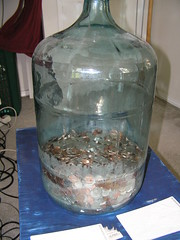 Every day when I get home I empty out my pockets of loose change and put them into a large glass waterbottle that sits behind my desk. Eventually this bottle becomes too heavy to move and I empty it out to reclaim some cash for toys.
Every day when I get home I empty out my pockets of loose change and put them into a large glass waterbottle that sits behind my desk. Eventually this bottle becomes too heavy to move and I empty it out to reclaim some cash for toys.
It occurred to me that there might be a way to estimate how much money was in the bottle by averaging out weights a little bit. Since my current ‘hottest toy’ want is a new Canon digital SLR camera, my ‘go for it’ point is somewhere around $750. The Coinstar machines now support converting your cash directly into a credit at Amazon without the 9% ‘fee’ they normally extract. Yay! But do I have enough?
I started by finding out the weight of an empty glass bottle (the web knows all – 15lbs). Then I weighed the bottle with all the coins in it (67lbs), which gives me about 52lbs of coinage to work with.
Because I don’t really have a distribution chart showing how many coins of each type I have, I assumed an even distribution. There’s probably more pennies than quarters, but I’ve never sorted things out. When I run the Coinstar dump, it’ll tell me how many of each coin I have, and that will make this more accurate the next time I do it.
Given that, some more googling gave me coin weights, so I was able to work it out…
Coin Value Weight(g) Penny 0.01 2.5g Nickel 0.05 5g Dime 0.10 2.68g Quarter 0.25 5.6g Average weight: 3.945g Average value: 0.10 Approximately .10 per 3.945grams or 0.025 cents per gram
Cool. My bottle has 52lbs of coins in it, which is around 23kilograms, which works out to around $544.00 worth of coins
Not quite there yet, but if I wait much longer, I may not be able to move the bottle. Maybe Zach and I will make an excursion to the Coinstar machine and shovel coins into it for a half hour, and see how accurate my numbers are.

 Darwinia is very much a ‘god game’ in that you are ‘above’ the life forms you’re interacting with, but, like Populous, you can’t directly control them. You can influence them in several ways (“All citizens, you feel an urge to move sort of in that direction!”), but can’t give the “you guys, move there and build a building, you guys, there and shoot them” sort of detail that’s common in things like Starcraft.
Darwinia is very much a ‘god game’ in that you are ‘above’ the life forms you’re interacting with, but, like Populous, you can’t directly control them. You can influence them in several ways (“All citizens, you feel an urge to move sort of in that direction!”), but can’t give the “you guys, move there and build a building, you guys, there and shoot them” sort of detail that’s common in things like Starcraft.